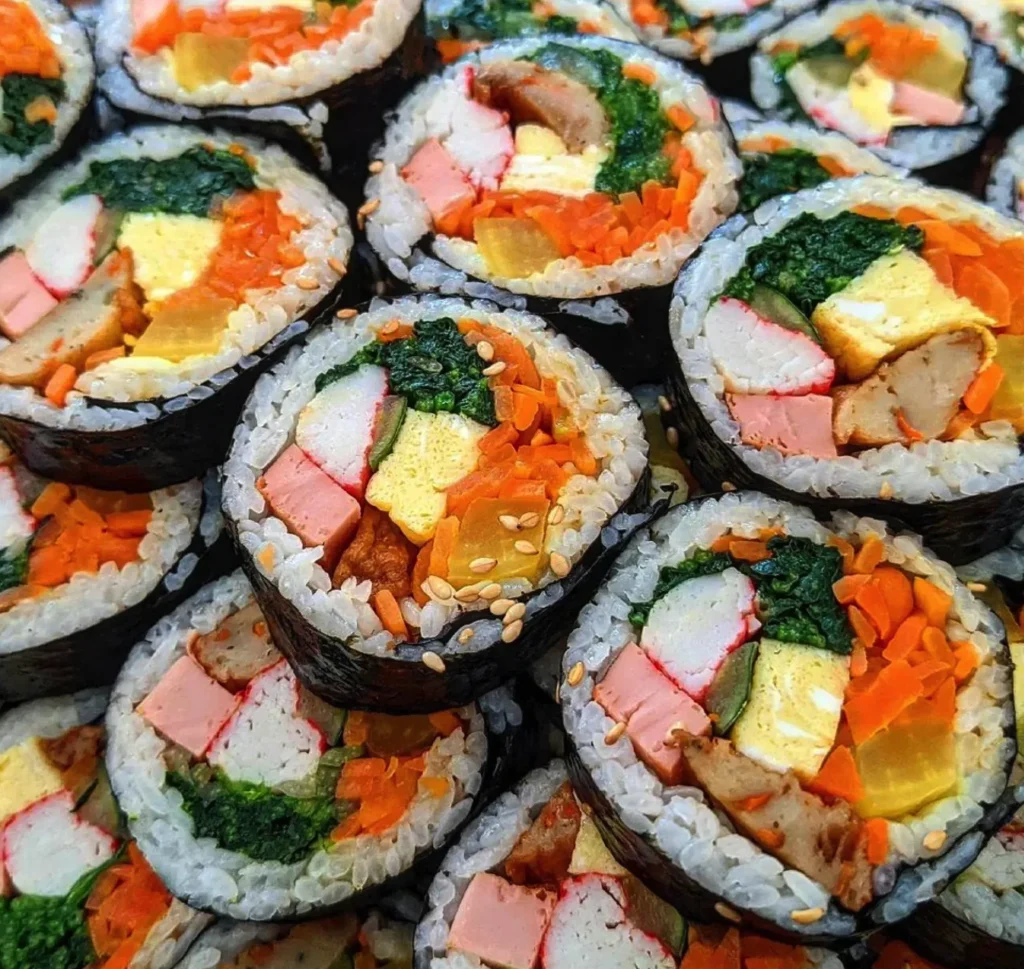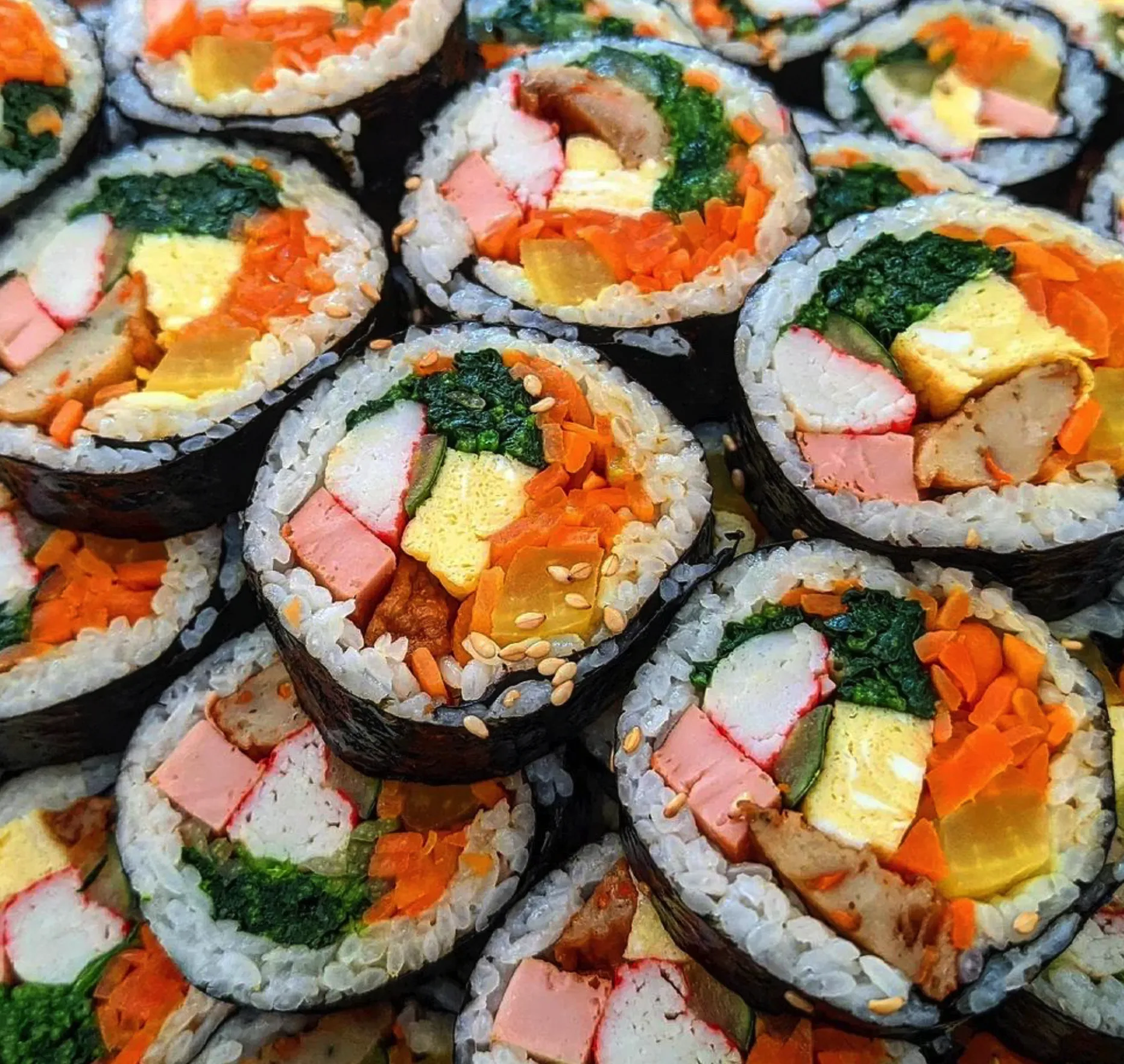Delve into the world of Kimbap, Korea’s beloved rice roll wrapped in seaweed. From its humble origins to its modern-day variations, this blog post unravels the rich history, cultural significance, and culinary versatility of Kimbap. Whether you’re a seasoned Kimbap enthusiast or a curious foodie, join us on a flavorful journey as we explore the stories, traditions, and tastes that make Kimbap more than just a meal – it’s a symbol of Korean heritage.
1. Introduction: Unwrapping the Delight of Kimbap
Kimbap, often referred to as the “Korean sushi,” is a culinary masterpiece that encapsulates the essence of Korean cuisine and culture. At first glance, it might seem like a simple rice roll wrapped in seaweed, but there’s so much more to this delightful dish than meets the eye.
Originating from the Land of the Morning Calm, Kimbap is a harmonious blend of flavors and textures, each ingredient carefully chosen to complement the other. The soft and sticky rice, the crisp vegetables, the savory fillings, and the slightly salty seaweed come together to create a bite-sized piece of heaven.
But what truly sets Kimbap apart is its versatility. Whether you’re on the go, on a picnic, or simply craving a wholesome snack, Kimbap is the perfect choice. It’s not just a dish; it’s an experience. As you take that first bite, you’re not just tasting food; you’re immersing yourself in a rich tapestry of Korean history, tradition, and innovation.
In this blog post, we’ll embark on a journey to explore the world of Kimbap. From its historical roots to its modern-day variations, we’ll unwrap the layers of this iconic dish and delve deep into its significance in Korean culture. So, grab your chopsticks and join us as we unravel the delightful world of Kimbap!

2. History of Kimbap: From Humble Beginnings to a National Treasure
The form of Kimbap enjoyed in Korea today was born under the influence of “Norimaki (海苔巻き)”. Directly translated, “Norimaki” means ‘seaweed roll’. These are distinctive Japanese seaweed dishes. This style was introduced to the Korean peninsula during the late Joseon period and the Japanese colonial era. After the liberation and through the economic growth period, it was localized and rearranged to fit Korean food culture, reborn with indigenous ingredients and flavors. This evolution can be considered the birth of the Korean Kimbap.
Even before the Japanese colonial era, flat seaweed was consumed in the Korean peninsula, and rice or other grains were wrapped in seaweed to eat, known as “Kim-ssam”. However, as the name “ssam” (meaning ‘wrap’) suggests, its form was somewhat different from today’s Kimbap. The Kimssam of that time was literally like lettuce or cabbage wraps, where rice and various ingredients were placed on flat seaweed and wrapped by hand to eat. The method of laying rice on flat seaweed, adding ingredients, rolling it with bamboo, and then slicing to eat was introduced from Japan.
In Japan, “Norimaki” is made by spreading rice on a square-cut seaweed, adding elongated sliced ingredients, and then rolling it into a cylindrical shape using a “Makis” (巻きす, bamboo rolling mat). This method, influenced by Norimaki, is similar to the Kimbap-making method. Before the introduction of Norimaki to the Korean peninsula, there was no food made using this cooking tool and method. Early 20th-century newspaper articles describe the introduction of Norimaki to the peninsula. In these descriptions, although the manufacturing method is the same as today, both Japanese and Korean seaweeds were used, and there were cases where “Umeboshi” (a type of pickled plum, rarely used in Korea today) was used. For the early Kimbap, rice was seasoned using vinegar.
The method of seasoning Kimbap without using vinegar emerged in the late 1970s. At least until the mid-1970s, the influence of the Norimaki preparation method was still present, and vinegar was used instead of sesame oil. Moreover, traditional Korean cuisine rarely uses vinegar-seasoned rice, known as “Choban”. Therefore, it’s hard to deny that Kimbap was influenced by Norimaki.
The practice of using Choban in Kimbap continued until the 1980s. Until then, Kimbap was considered less of an everyday food and more of a ‘special food to pack for picnics’. When packing Kimbap as an outdoor lunch, it was essential to use Choban because, in some cases, the rice could spoil without it. The vinegar in Choban acted as a preservative, preventing the food from going bad. The culture of eating convenient Norimaki during picnics or sports days was propagated during the Japanese colonial era, and the image of Kimbap as a picnic food in modern Korea was influenced by this.
The use of vinegar in Kimbap began to decline during the 1980s. Until then, Kimbap was a special dish, often prepared at home the night before a picnic. Typically, a large quantity was made for the entire family to eat, and vinegar was used to preserve it for consumption even after the day it was made. However, with the widespread availability of refrigerators in households during the 1980s, there was no longer a need to use vinegar to prevent Kimbap from spoiling. As Kimbap became an ‘instant food that can be quickly and cheaply purchased’ in restaurants, its status as a preserved food disappeared. Consequently, the cumbersome Choban was replaced with regular rice, and the sour taste was substituted with pickled radish (Danmuji). The most significant difference between modern Korean Kimbap and Japanese Norimaki lies in the rice, pickled radish (Danmuji), and the presence or absence of sesame oil.
Recently, Kimbap has been enjoyed together with Tteokbokki and Sundae.
3. Preparation of Kimbap: Crafting the Perfect Roll
Creating the perfect Kimbap is an art that requires precision, patience, and a passion for flavors. While the dish might seem simple, the intricacies involved in its preparation can make all the difference between a good roll and a great one. Let’s delve into the steps and secrets behind crafting the perfect Kimbap.
Choosing the Right Ingredients:
- Rice: Opt for short-grain or sushi rice. It’s stickier than its long-grain counterpart, ensuring the roll holds together well.
- Seaweed (Gim): Choose roasted seaweed sheets that are crisp and free from any moisture.
- Fillings: Common fillings include pickled radish (Danmuji), spinach, carrot, cucumber, and proteins like beef or fish cake. Always ensure they’re fresh and well-prepared.
Seasoning the Rice: Traditionally, the rice for Kimbap is seasoned with sesame oil and a pinch of salt. This gives it a distinct flavor that sets it apart from sushi. Ensure the rice is cooled to room temperature before seasoning to prevent it from becoming too sticky.
Rolling the Kimbap:
- Lay the Seaweed: Place a sheet of seaweed on a bamboo rolling mat (Makis). Ensure the shiny side is facing down.
- Spread the Rice: Gently spread a layer of seasoned rice on the seaweed, leaving about an inch at the top edge.
- Add the Fillings: Place your chosen fillings horizontally in the center of the rice.
- Roll: Using the bamboo mat, start rolling from the bottom, applying even pressure to ensure a tight roll.
- Seal: Dab a little water on the top edge of the seaweed to seal the roll.
Slicing and Serving: Using a sharp knife, slice the roll into bite-sized pieces. Pro tip: Keep the knife slightly wet to ensure clean cuts. Serve with a side of soy sauce or a dipping sauce of your choice.
4. Variations of Kimbap: Beyond the Classic – Exploring Diverse Flavors
Kimbap can be made in a variety of ways, much like a sandwich, and depending on what ingredients are put inside, a different kind of Kimbap is created. So, Kimbap has evolved over the years to encompass a myriad of flavors and styles. While the classic Kimbap remains a beloved choice, there are numerous variations that cater to diverse palates. Let’s embark on a culinary journey to explore some of these delightful Kimbap variations.
1. Tuna Kimbap (참치 김밥): A delightful choice for seafood enthusiasts, Tuna Kimbap features flaky canned tuna, often mixed with a hint of mayo for creaminess. The savory taste of tuna combined with crisp vegetables offers a refreshing bite every time.
2. Cheese Kimbap (치즈 김밥): Blending the best of Korean and Western flavors, Cheese Kimbap incorporates creamy slices of cheese, creating a melt-in-the-mouth experience. This modern twist is especially popular among kids and cheese lovers alike.
3. Bulgogi Kimbap (불고기 김밥): A treat for meat aficionados, this variation stars bulgogi – marinated and grilled beef that’s both sweet and savory. Paired with the classic Kimbap ingredients, it’s a hearty and flavorful roll that’s hard to resist.
4. Kimchi Kimbap (김치 김밥): For those with a penchant for spicy and tangy flavors, Kimchi Kimbap is a must-try. Featuring fermented kimchi, this variation adds a zesty kick to the traditional roll, making it a favorite among spice enthusiasts.
5. Tonkatsu Kimbap (돈까스 김밥): A fusion of flavors, Tonkatsu Kimbap includes a crispy breaded pork cutlet (tonkatsu) as its star ingredient. The crunchy texture of the tonkatsu paired with the soft rice and seaweed creates a delightful contrast in every bite.
6. Chungmu Kimbap (충무 김밥): A minimalist yet flavorful variation, Chungmu Kimbap typically consists of small rice rolls wrapped in seaweed, served with spicy radish salad and squid. It’s a nod to the traditional flavors of the coastal town of Chungmu, where this unique style originated.
5. Perspective of Kimbap in Korea: More than a Meal – A Cultural Icon
In the bustling streets of South Korea, amidst the aroma of sizzling street food and the chatter of daily life, one can often spot the familiar sight of a Kimbap stall. This simple rice roll, wrapped in seaweed and filled with various ingredients, is more than just a popular snack or meal in Korea; it’s a cultural icon that holds a special place in the hearts of many.
1. A Symbol of Nostalgia: For many Koreans, Kimbap evokes memories of childhood. It’s the food that mothers lovingly prepared for school picnics, the snacks that friends shared during outings, and the comfort food that always seemed to be there during moments of hunger. The act of rolling and sharing Kimbap is, for many, a cherished memory of family bonding and simpler times.
2. Versatility and Adaptability: Kimbap’s ability to adapt and evolve is a testament to Korea’s dynamic food culture. From the classic vegetable and meat fillings to modern variations like cheese and bulgogi, Kimbap reflects the country’s culinary innovation and openness to new flavors.
3. A Reflection of Korean History: The evolution of Kimbap is intertwined with Korea’s history. From its early influences from Japanese norimaki during the colonial period to its post-war localization with ingredients more familiar to Korean palates, Kimbap’s journey mirrors the nation’s resilience and adaptability.
4. Kimbap and Korean Pop Culture: Kimbap has made its mark in Korean dramas, movies, and variety shows. Whether it’s a scene of a mother preparing Kimbap for her child or characters enjoying a Kimbap meal together, this dish often plays a role in showcasing everyday Korean life and relationships.
5. Beyond Borders – Kimbap’s Global Appeal: While deeply rooted in Korean culture, Kimbap’s appeal is universal. As Korean culture gains popularity worldwide, thanks to the Hallyu wave, Kimbap has found fans across the globe. Its simplicity, versatility, and delicious taste make it a favorite even among those unfamiliar with Korean cuisine.
Final Thoughts: Kimbap, in its essence, is a reflection of Korea’s soul. It’s a dish that tells stories of family, history, innovation, and shared experiences. More than just a meal, Kimbap stands as a testament to Korea’s rich cultural tapestry and its enduring spirit. As we enjoy each bite, we’re not just savoring flavors but also partaking in a rich cultural legacy.
